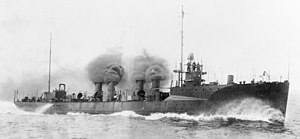 USS Flusser
| |
| Class overview | |
|---|---|
| Name | Smith class |
| Operators | |
| Preceded by | Truxtun class |
| Succeeded by | Paulding class |
| Subclasses | Flusser |
| Built | 1908–1910 |
| In commission | 1909–1919 |
| Completed | 5 |
| Scrapped | 5 |
| General characteristics | |
| Type | Destroyer |
| Displacement |
|
| Length | 293 ft 10 in (89.56 m) |
| Beam | 26 ft 0 in (7.92 m) |
| Draft | 8 ft 0 in (2.44 m) |
| Installed power |
|
| Propulsion | 3 × shafts |
| Speed | 28 knots (52 km/h; 32 mph) (design) |
| Range | 2,800 nautical miles (5,200 km) at 10 knots (19 km/h; 12 mph) |
| Capacity | 304 long tons (309 t) coal (fuel) |
| Complement |
|
| Armament |
|
The Smith-class destroyers were the first ocean-going torpedo-boat destroyers in the United States Navy, and the first to be driven by steam turbines instead of the reciprocating engines fitted in the sixteen earlier and much smaller torpedo-boat destroyers ordered under the Act of 4 May 1898. Flusser and Reid are sometimes considered to be Flusser-class ships. Also, since Flusser was completed first, some period documentation refers to the entire class as Flussers.[1]
The first three of the class were ordered under the Act of 29 June 1906 "to have the highest practical speed, and to cost, exclusive of armament, not to exceed seven hundred and fifty thousand dollars each". The remaining pair were ordered under the Act of 7 March 1907 "to have the highest practical speed, and to cost, exclusive of armament, not to exceed eight hundred thousand dollars each".[1]
All of the ships served as convoy escorts in World War I, and several attacked U-boats. The latter four vessels were all sold in November 1919 following the end of World War I; Smith survived another two years as a bombing target until scrapped.[2]
- ^ a b Friedman, pp. 22–28, 454–455
- ^ DestroyerHistory.org Smith class destroyer